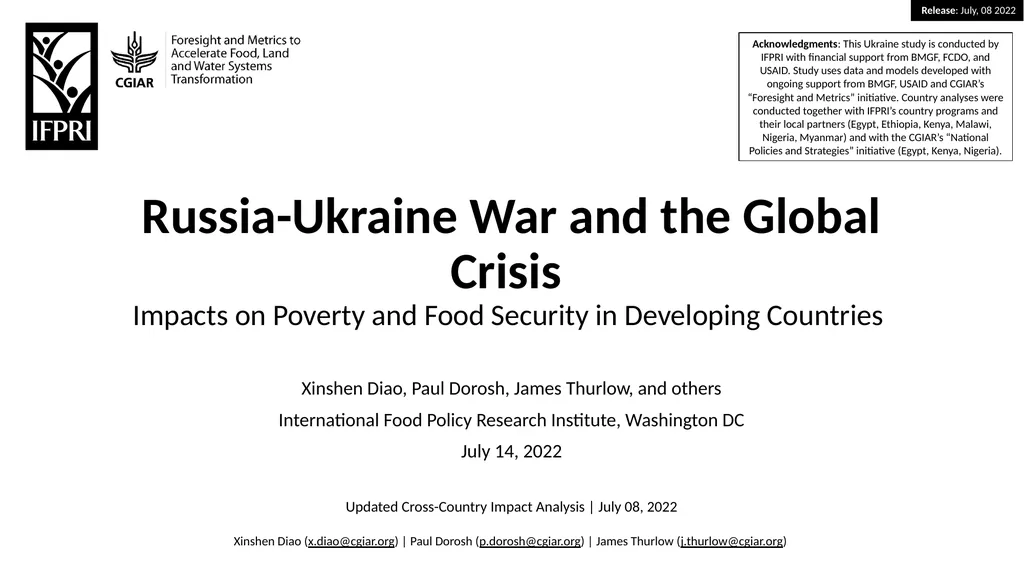Russia-Ukraine War and the Global Crisis Impacts
Author : jane-oiler | Published Date : 2025-11-07
Description: RussiaUkraine War and the Global Crisis Impacts on Poverty and Food Security in Developing Countries Xinshen Diao Paul Dorosh James Thurlow and others International Food Policy Research Institute Washington DC July 14 2022 Updated
Presentation Embed Code
Download Presentation
Download
Presentation The PPT/PDF document
"Russia-Ukraine War and the Global Crisis Impacts" is the property of its rightful owner.
Permission is granted to download and print the materials on this website for personal, non-commercial use only,
and to display it on your personal computer provided you do not modify the materials and that you retain all
copyright notices contained in the materials. By downloading content from our website, you accept the terms of
this agreement.
Transcript:Russia-Ukraine War and the Global Crisis Impacts:
Russia-Ukraine War and the Global Crisis Impacts on Poverty and Food Security in Developing Countries Xinshen Diao, Paul Dorosh, James Thurlow, and others International Food Policy Research Institute, Washington DC July 14, 2022 Updated Cross-Country Impact Analysis | July 08, 2022 Acknowledgments: This Ukraine study is conducted by IFPRI with financial support from BMGF, FCDO, and USAID. Study uses data and models developed with ongoing support from BMGF, USAID and CGIAR’s “Foresight and Metrics” initiative. Country analyses were conducted together with IFPRI’s country programs and their local partners (Egypt, Ethiopia, Kenya, Malawi, Nigeria, Myanmar) and with the CGIAR’s “National Policies and Strategies” initiative (Egypt, Kenya, Nigeria). Xinshen Diao (x.diao@cgiar.org) | Paul Dorosh (p.dorosh@cgiar.org) | James Thurlow (j.thurlow@cgiar.org) Overview Phase 1: Impact analysis Use country models to assess the impacts of global shocks on economies and populations Phase 2: Policy response analysis Compare the effectiveness of broad policy responses by governments and their development partners Phase 3: In-depth analysis with partners Tailor scenarios to policy and investment options Bangladesh Cambodia DRC Egypt Ethiopia Ghana Kenya Mali Malawi Myanmar Niger Nigeria Nepal Philippines Rwanda Senegal Tanzania Uganda Zambia Burkina Faso Guatemala Mozambique Tunisia Yemen Included Underway Shocks, Impacts and Outcomes Economy: National and agri-food system GDP Population: Household incomes, poverty, and food security (i.e., hunger and diet quality) What is the share of the affected commodities in total trade? How important are imports in local markets and across supply chains? Are commodities a large part of consumer baskets? How much fertilizer was used before the crisis, and how sensitive is fertilizer demand to rising prices? Changes in world prices for food, fuels and fertilizers Effect of higher fertilizer prices on fertilizer use in the current cropping season (≈ 1-year time horizon) Economy | Agri-Food Systems Adversely Affected Size of economic impacts vary widely Total GDP falls in most countries, but remains largely unchanged in some cases (e.g., Nigeria) Agri-food system GDP falls in most countries, and usually by more than total GDP Drivers of economic losses differ across sectors: Rising world fuel prices are (typically) the main contributor to falling national GDP Fuel imports are often countries’ largest import Increase trade and transport costs for all products Higher fertilizer prices and falling fertilizer demand drive most agri-food system GDP losses Raises production costs and reduces productivity World food price changes also have larger implications for agri-food system GDP Impact of world price














